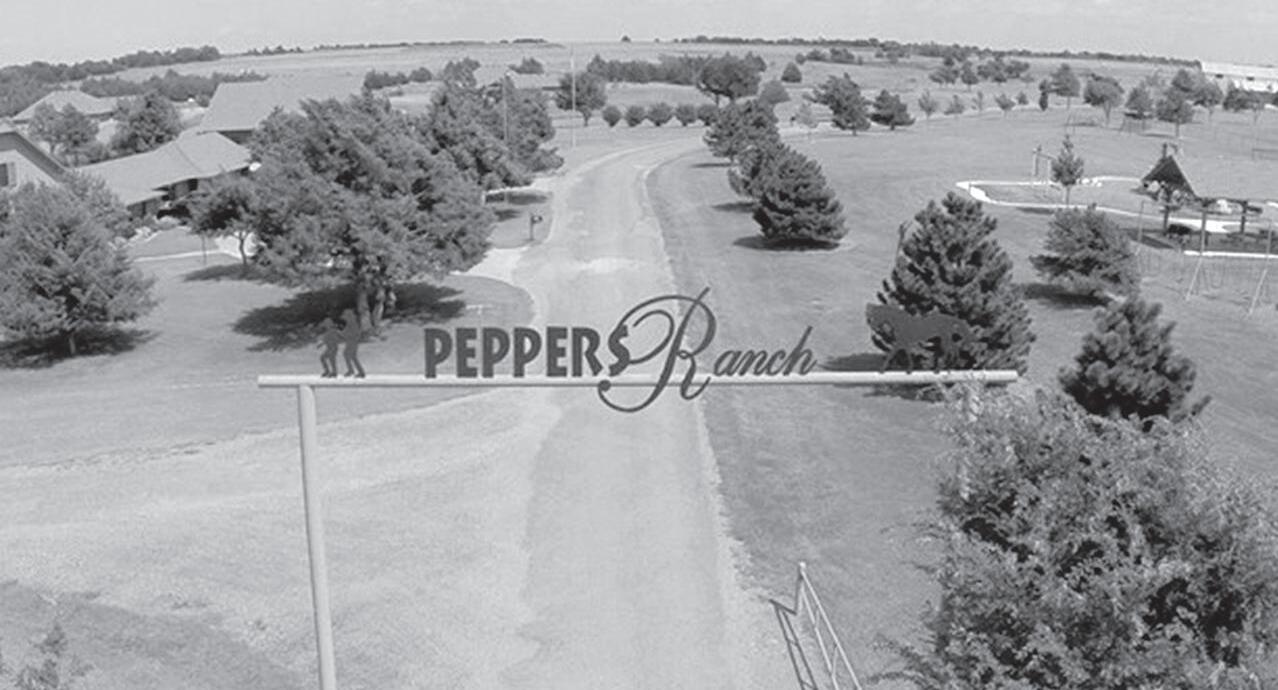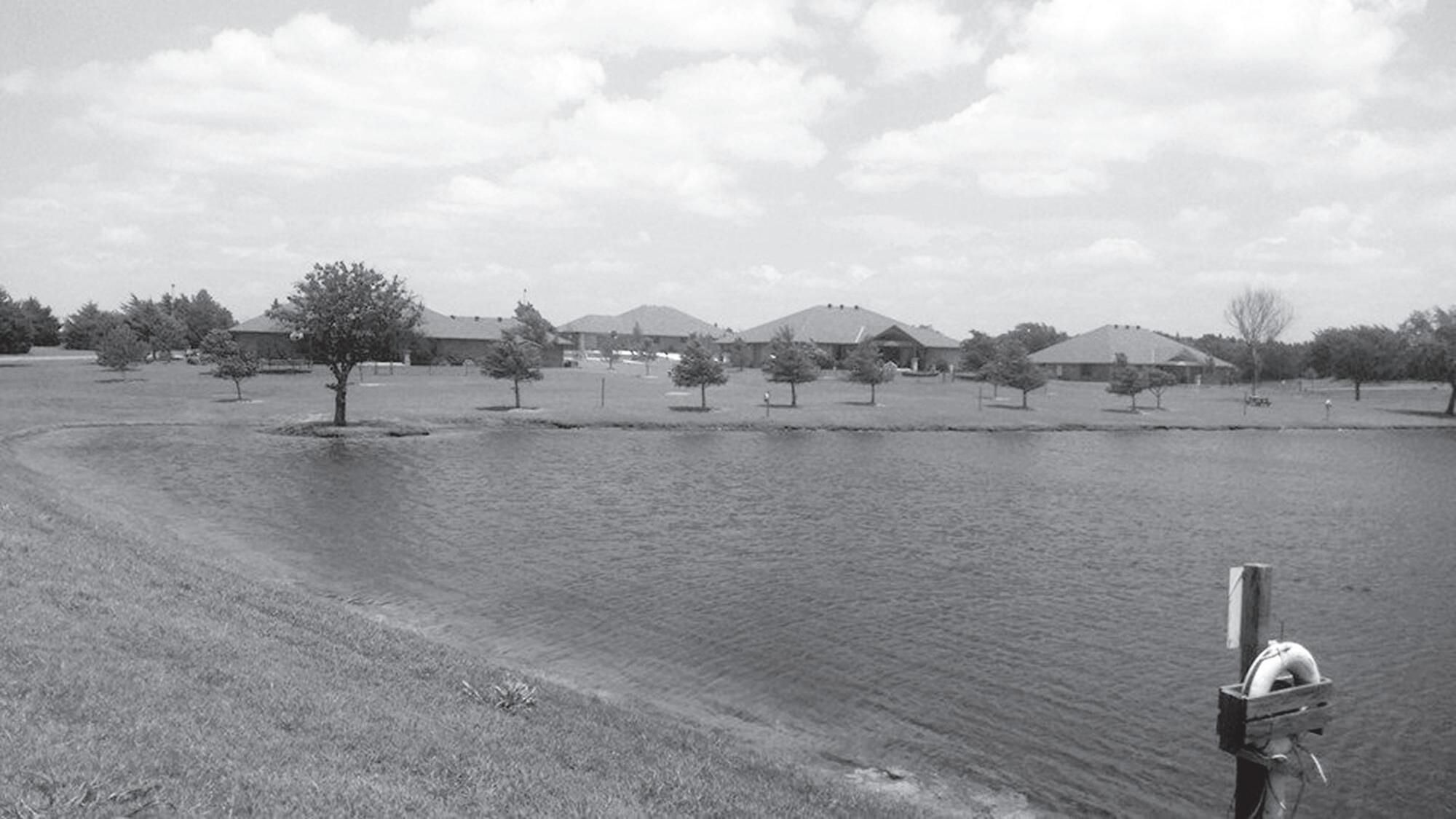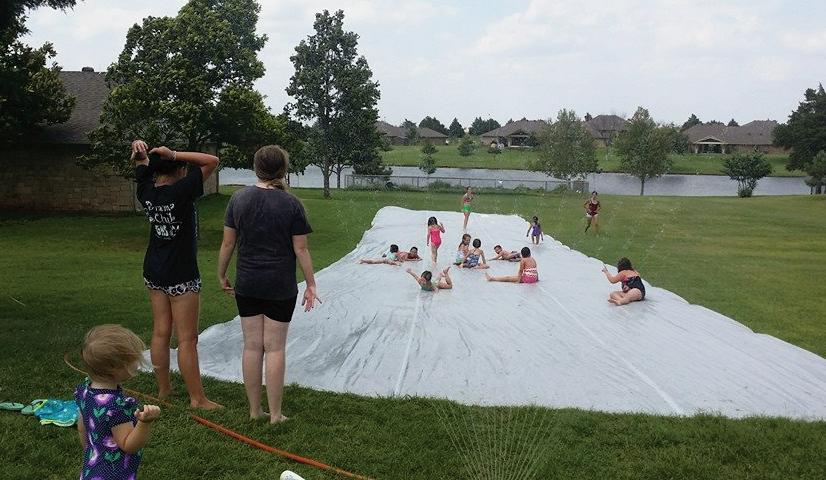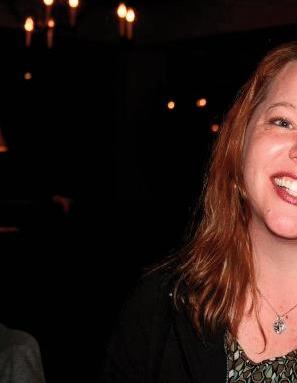
9 minute read
Meanw hil e, Back at th e R anch
By Chris Chmielewski Foster Focus Editor
It all starts on a dirt road that you would miss if you weren’t looking for it.
Advertisement
That dusty road becomes a strange metaphor of what lies ahead for the kids who find themselves on this gravel filled runway. Mysterious. Uncertain.
It is a long expanse of clay colored earth that leads to a plot of acreage that is changing how people in Oklahoma view foster care.
As you make your way down this stretch of road, just outside of Guthrie, properties begin to emerge; you’ll pass seven or eight of them before you reach your destination.
The road opens up to reveal a cast iron arch and gate. Above the arch, nestled between the silhouettes of a cowboy with a child and a horse are the words; Pepper ’s Ranch.
Back in 1999 this was all just sprawling land dotted with cattle.
The land, all 160 acres of it, was donated to the ranch with the intention of creating a boys group home
The first building went up a few years later in 2002. Pepper ’s Ranch was on its way. A second home sprang up in 2005, quickly followed by an equestrian center a couple months later An agriculture center would complete the 2006 landscape But there needed to be more.
The Pepper ’s Ranch model was working The boys were doing well The programs were effective but only serving a small group of boys. They felt they could do more.
They began to research exactly what they could do. They studied what other states had done, what worked, what didn’t They researched group homes and foster care communities in other states and decided that a foster care community was just what Oklahoma needed
In 2009 Pepper ’s Ranch became Oklahoma’s first foster care community

Here’s what that means A foster care community is basically a group of foster care families in close proximity to one another These families all work in conjunction to produce the best outcomes for kids in their care.
That’s it Foster families that share a neighborhood. There’s more that goes into it but that’s the basic definition Once the decision to be a foster care community was reached the houses began to pop up
Those two homes became ten homes. The Ag and equestrian centers were joined by a multi-purpose learning center, complete with a library, classrooms and a basketball court The once wild terrain morphed into a quaint neighborhood. Paved roads, beautiful homes and a manmade lake where the kids can fish are now the landscape of this growing community.
I had to see it for myself
I arrived at the ranch on a brisk November morning I took that long dusty road and my first thought was; “If I were a kid, it would feel like this road will never end!”
I was met by nearly a dozen toddler aged kids of all backgrounds making their way to a van that would take them up the hill to the learning center After driving for the better part of a week, meeting foster care folks all over the Midwest, the smiles on the faces of those adorable kids were a welcomed change of pace.
After a bunch of hellos and high fives I was greeted by the ranch’s Executive Director, Tonya Hagen-Ratcliff Not only is Tonya the Executive Director but she’s also an adoptive mom and fos- ter parent right there on the premises I’m a big fan of those who stay in the game. It would be easy to drive down the road to her own life, separate from the ranch, but if you meet Tonya you’ll find that isn’t an option for her, she’s all in
She’s a happy, passionate person but you can see the seriousness with which she approaches the community
I was given a brief tour of her home that she shares with her husband of 14 years Travis and their kids; Evan age 10, Elliott age 9, Coy age 7, JT age 7, Reese age 5, Emma age 4, Ellis age 3 and Anthony, age 2 .
Tonya is Oklahoma through and through, born and raised in Oklahoma City which is just a short drive away She went to college at Central Oklahoma, is a die-hard Oklahoma City Thunder fan (we’ll talk about that shortly) and is the epitome of a Oklahoman; tends to animals, drives four wheelers and isn’t afraid of wildlife That “do everything” attitude lends itself well to her current position as the caretaker of a community of likeminded families working to improve the lives of kids who may have found themselves in a far different situation.
I invited a friend of mine from the Arrow agency in Texas named Keith Howard Keith is a foster parent and a Director at Arrow Moreover, he cares about kids, cares about foster care and happens to be someone I respect and call friend Keith is also an Okie who was in the area visiting family at the time of my visit to the ranch I like connecting people so it was a no brainer that I invite him.
Once Keith arrived it was time to see the rest of the ranch.
It’s a lot bigger than I had anticipated I’m an east coast guy; we kind of stack our houses on top of one another around here Pepper ’s Ranch’s homes are spread out. There’s plenty of room to roam around while still being within the eye line of parents In my mind, I thought “It would be IMPOSSIBLE to run away from this place You could run for hours and everyone could still see you, the hills are more like mounds, very flat land ” But when you’re here for a bit, you see, no kid would really want to bolt from this place.
Our first stop was that multi-purpose learning center. It’s a large building that gets larger once you get inside As we entered the double doors there was a surprisingly well stocked library to the right and a classroom to the left Entering the second set of double doors we are in the basketball court where kids are running, playing and reading throughout Just off the court were more classrooms.
In one of the classroom I met a little boy creating a hand turkey masterpiece. He smiled as he dutifully glued feathers on to the construction paper Innocence Pure Joy.
The walls of the gym are adorned with paintings and framed articles of Pepper ’s success stories The atmosphere is light Happy The kind of place that would have become my safe haven when I was in care There’s something calming about a place designed specifically for play. My hours spent at the YMCA came streaming back as we walked the carpeted floors to the different corners of the gym.
We walked back outside to find a snocone trailer parked in front of the building Tonya explained that a tornado hadn’t randomly dropped this cart here, rather it was donated. Pepper ’s donors are one of the reasons these kids have so many options on the ranch
After I daydreamed of sno-cones and summer days at the ranch for a few minutes, we headed to the Ag center.
When I say Tonya is Oklahoma, you need look no further for proof than to read the names of the animals at the ranch
The star of the animal team is a goat named Kevin Durant Yep Kevin Durant, the star Forward for the Oklahoma Thunder There are also chickens named Russell Westbeak and Serge Ibeaka (Russell Westbrook and Serge Ibaaka also of the Thunder) The fun just oozes out of this place
I guess you could say that I’m kind of urban The animal time was filled with me not wanting to touch the goats or horses and not being very interested in meeting the chickens I prefer to meet these animals on a plate. Seeing them makes me question my eating habits After getting our fill of animals, we made our way around the neighborhood Looking at the homes, learning about the people who inhabit these houses.
The process of becoming a Pepper ’s Ranch family is akin to working at the Pentagon Background checks, questionnaires, credit checks, references
The works.
Tonya explains that this community is collaborative effort and all steps must be taken to ensure that the best families populate the neighborhood
The entry process, while a rigorous one, is effective and fair
Applicants (foster parents) are asked to provide things like; why they foster, whether they are short or long term foster parents? In addition, they are asked to describe their personalities and parenting styles. Following an evaluation of their answers and the reference and background check requirements are met they are asked to visit the ranch.
It’s at this point that the decision is really made. They tour the ranch and interact with the other families to make sure both the applicants and the existing ranchers are comfortable with one another An interview with the Pepper ’s Ranch Board of Directors and Parent Committee conclude the process and a decision is rendered
Logic says that with this intense a vetting process and attention being paid to everyone’s comfort that diversity may be lost. That isn’t the case at Pepper ’s. Though the ranch’s occupants are predominantly white, mainly because Oklahoma is prominently white, there is a very diverse community at play Nearly all races are represented In addition, the original idea of a group home for boys evolved into a community that houses both boys and girls with an emphasis on keeping siblings together.
Of the 70-plus children that live with the 12 families that comprise the ranch, 48 of those children are siblings There’s an even split between boys and girls at last count. The average age is 7. While some are biological children, 11, the bulk are adopted, 35, or foster children, 25. The emphasis on care and adoption from care is prevalent
If an applicant is accepted, it’s moving day!
Accepted applicants move in to spacious homes with plenty of room for all family members big and small The payment arrangement is simple; families pay a ridiculously small monthly fee to the Tennant’s Association for events and upkeep. Consider it a kind of rent A seriously low rent, but a kind of rent nonetheless
That goal is a normal, healthy life for the kids who live here Adopted, biological or foster, the kids are the focus of everything that happens here.

There is art therapy, pet therapy, horse riding, drama therapy, sports and exercise programs, as well as on-site therapy and counseling
All of these programs are geared toward breaking the cycle of abuse and neglect way to deal with whatever trauma they’ve been through is enormous Often times, when it comes to foster care, kids are treated with a one size fits all mentality This way of thinking has accounted for the high percentage of prescribed psychotropic drugs among foster youth It seems that with the Pepper ’s model there’s no rush to judgement. A child is looked at as a partner in the healing process
Accepted applicants have some rules to follow for that next to nothing rent Foster parents are required to have a minimum number of foster youth in their home at all times One of the parents must maintain a full time job. There are home inspections and all the other aspects of being a foster parent in place. Bills must be paid on time and you must keep the home in great condition There are other guidelines and rules in place to ensure that the best families populate the ranch Small price to pay to live in a community where everyone is working toward the same goal that so many of the kids that live here have faced in their short lives
Tonya says, “By teaching these children the components of healthy living, quality life skills, and giving back to society we can break that cycle.” She may be right
The diversity of the Pepper ’s Ranch model may be the key to its success With so many therapeutic programs within the families’ reach, it gives the kids more of a chance to find the one that suits them
What that can do for a child who needs a little extra time to find a comfortable
As with all things foster care related, time will tell how successful the ranch and its’ programs are But in the short term, there have been plenty of success stories Siblings able to stay together despite being in the foster care system, kids finding their way to college or a normal life and the growth of the ranch may be the biggest indicator of success Once a field for grazing cattle and wildlife, this acreage has been transformed much like the lives of the families who currently inhabit the land.
The old adage has always been “it takes a VILLAGE to raise a child”. Maybe it takes a ranch?













